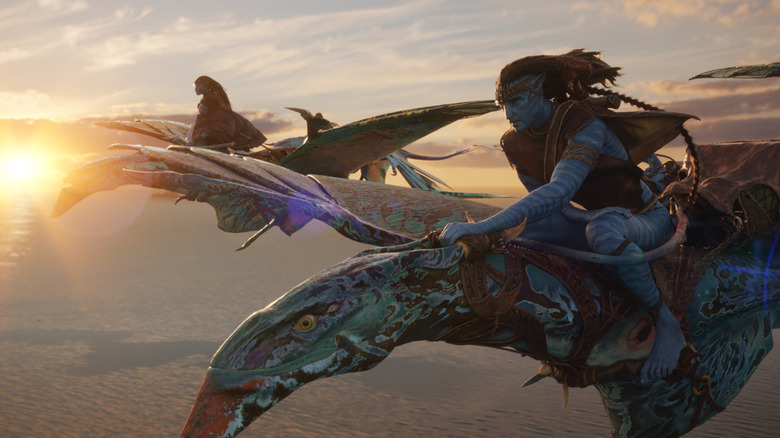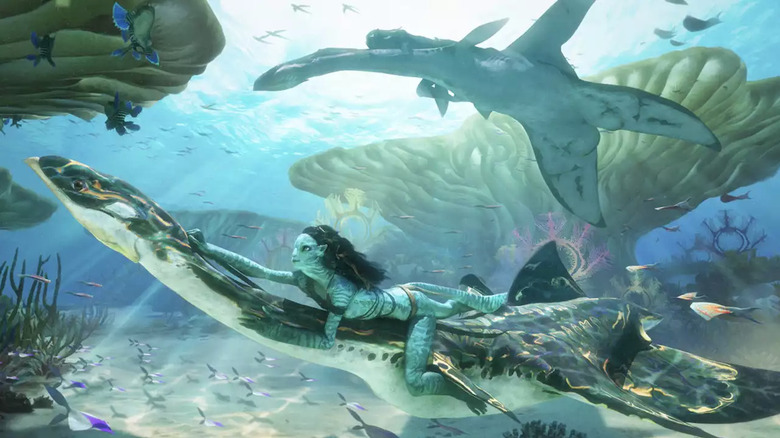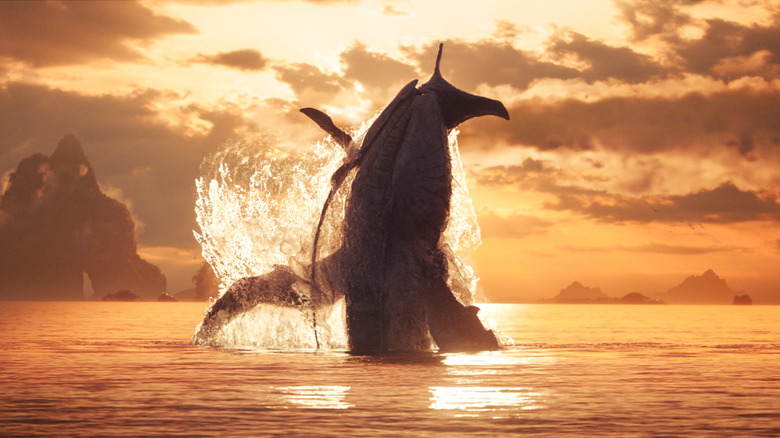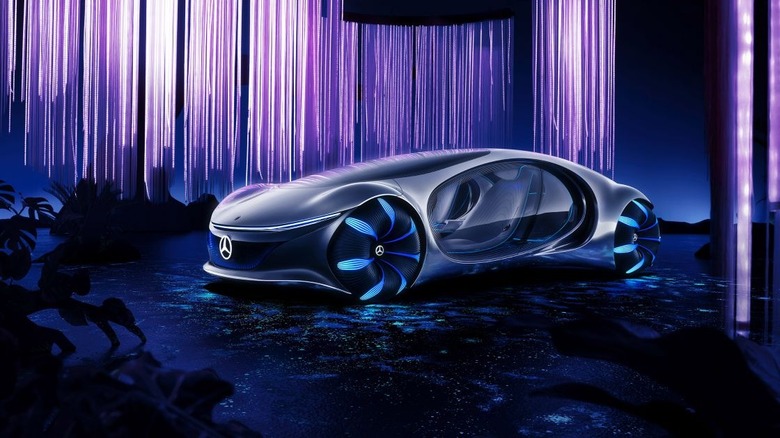All The Ways You Can Donate To Environmental Causes Inspired By Avatar: The Way Of Water
"Avatar: The Way of Water" wears its environmentalist heart on its sleeve, crafting a naturalistic world brimming with wondrous marine life. Extended sequences of intense underwater beauty serve as reminders that an entire world is bubbling just under the surface. And that world needs to be protected. The space whale mammals called the tulkun are hunted by hired guns employed by the evil RDA (Resources Development Administration) corporation and, as a result, are in jeopardy of becoming an endangered species. Director James Cameron is drawing a clear comparison to the whaling industry here on Earth that, once upon a time, became an important component of the Industrial Revolution. In Cameron's pro-nature sequel, the native tulkun are killed for a valuable element called amrita, a yellow substance found in the skulls of the species that apparently has the ability to stop human aging. Clearly, the tulkun and the oceans they call home need an ally.
Experiencing the incredible natural world of Pandora may make you want to support causes in our world that can help to protect our oceans. The strong family themes found in the film have also inspired organizations like Variety — the Children's Charity to create a promotional tie-in with Cameron's epic to help provide life-changing equipment for children who live with special needs or who are disadvantaged. For a minimum donation of just $3.00, fans can pick up a limited-edition gold heart pin featuring artwork from the film at participating theaters nationwide.
The Variety gold heart campaign is just one of the ways people can help. If "Avatar: The Way of Water" sparked some interest in oceanography, animal conservation, or leaving a lighter carbon footprint, please consider donating to the initiatives below!
Support the Nature Conservancy
The events of "Avatar: The Way of Water" take place roughly 15 years after "Avatar" in the year 2169. What will our own oceans look like in 150 years? If that's not a concern, today in 2022, rising water temperatures are endangering marine life, damaging coral reefs, and eroding entire ecosystems. Rising sea levels will also continue to become a problem in years to come. This is certainly cause for concern, and although we can't save the world in one day, there are steps we can take to soften the blow.
Cue James Cameron and the marketing power (and pocketbook) of the Disney Corporation. To promote the release of one of the most anticipated sequels of all time, Cameron and Disney have partnered up with The Nature Conservancy, a non-profit organization dedicated to protecting Earth's wildlife. On the official Avatar website, fans of the franchise can create their own aquatic creature in a virtual Pandoran ocean in order to help protect the habitats of 10 amazing species here on Earth. First, pick a sea level depth that your fish will flourish in. (I chose the Mesopelagic, or Twilight Zone, as an homage to the classic series). Then, pick fin shapes and what kind of bioluminescent design pattern you prefer. After your fish is created, bookmark the page and follow your fish as it travels through the wonders of the Pandoran ocean. (I'm doing it now and it's incredibly relaxing to watch).
For every fish created, Disney US will donate $5 to the organization to help protect 10 percent of Earth's oceans by 2030. Fans have until December 31 of this year to participate. The tagline for the Nature Conservancy reminds us that the reason we study other worlds is to learn more about our own, a lesson that James Cameron would probably endorse wholeheartedly.
Save the Whales
Since 1977, the Save the Whales foundation has stayed dedicated to its mission of educating the public about marine mammals and emphasizing just how fragile the ocean environment really is. In 1986, a worldwide ban was placed on whaling, but that moratorium hasn't stopped the inhumane industry completely. Killings, captures, and bombings continue to threaten whales, dolphins, seals, and even birds that would otherwise be safe from harm. Consider becoming a member or donating to Save the Whales here.
In one of the most difficult scenes to watch in "Avatar" The Way of Water," Quaritch (Stephen Lang) instructs the tulkun harpooner Scoresby (Brendan Cowell) to start bombing and hunting the revered species just offshore, within the sacred territory of the Na'vi people. The explosives used are similar to what the U.S. Navy detonates in "Ship Shock" tests to determine the combat readiness of ships in the fleet. Recently, Save the Whales attorneys and scientific experts prevented the detonation of hundreds of these explosives that may wind up saving 10,000 marine mammals. Every donation helps facilitate those kinds of outcomes and aids in protecting these magnificent creatures. The Na'vi clans of the Metkayina would be proud of you!
Get on the waitlist for the Mercedes-Benz Vision AVTR
It may seem counterintuitive for a pro-environmental, anti-corporate franchise like "Avatar" to partner up with Mercedes-Benz. But the recent unveiling of the Vision AVTR concept car is the sort of groundbreaking design that could inspire the next generation to think differently. Could a vehicle based on concepts of coexistence in "Avatar: The Way of Water" really be the car of the future?
In what could be a step forward in the effort to leave a lighter footprint and lessen our overall environmental impact, the Vision AVTR model would be the first to use revolutionary new battery technology based on organic cell chemistry. If accomplished, the so-called electromobility could eliminate the need for toxic and expensive fossil resources.
Mercedes-Benz describes the overall design of the vehicle as "An organic symbiosis of human, machine, and nature." That description goes hand-in-hand with the ingenuity and central message of Cameron's "Avatar" films which are trying to teach us the importance of restoring balance between nature and technology, no matter what planet we're on.



